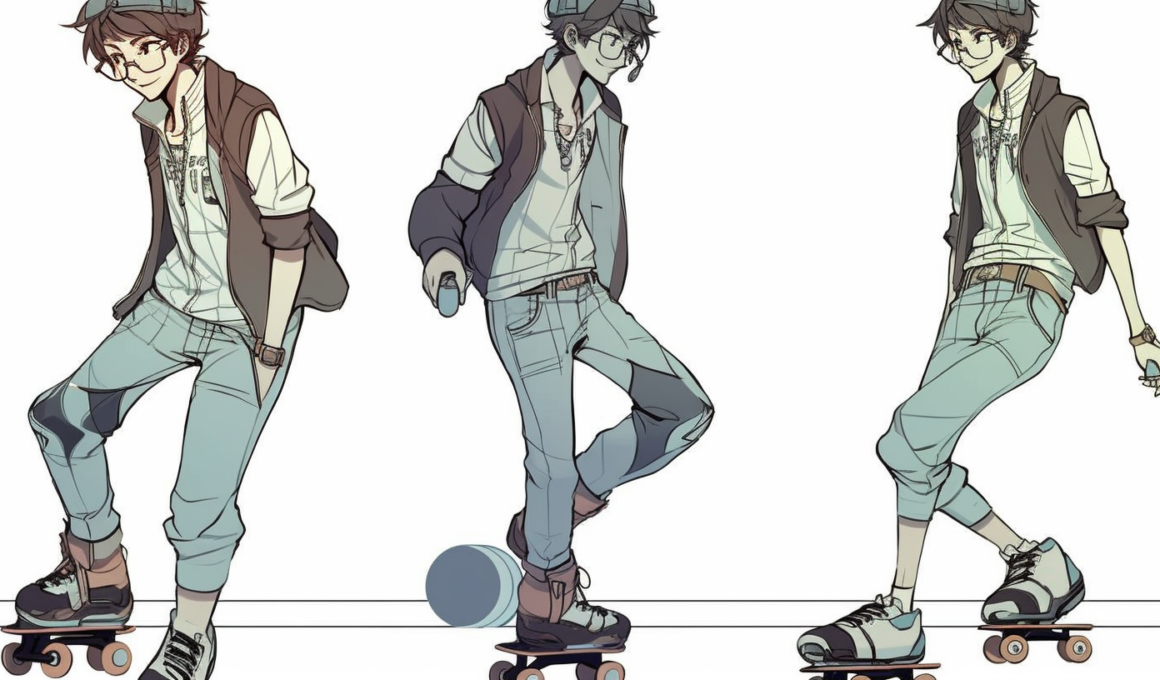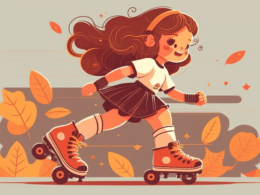Roller skating is a fun and exciting activity that can be enjoyed by people of all ages. Whether you’re a seasoned skater or just starting out, there are always ways to improve your skills and take your roller skating abilities to the next level.
This post will provide essential tips and techniques for improving your balance, posture, strength, and agility on roller skates. From choosing the right gear to practicing advanced maneuvers, we’ve got everything you need to know about how to get better at roller skating. So grab your quad skates and let’s get rolling!
Essential Practices For Improving Roller Skating Skills
Properly fitting and tightening skates, overcoming fear and learning to fall safely, improving balance and posture, and practicing basic skating fundamentals are essential practices for improving roller skating skills.
Properly Fitting And Tightening Skates
One of the most important aspects of improving your roller skating skills is to ensure that you have properly fitted and tightened skates. Ill-fitting skates can lead to discomfort and hinder your performance on the rink. First, make sure that you measure both feet accurately and purchase a skate size appropriate for the larger foot. Then, when putting on your skates, make sure they are snug and secure but not too tight as to restrict movement or blood flow.
Tightening your skates correctly is also crucial for optimal performance. The laces should be evenly tightened from top to bottom, with no gaps or looseness around the ankle area. It’s also essential to tie them firmly enough so that there is no slippage in the heel, which can cause blisters or injuries over time. Remember, taking a few extra minutes before skating to ensure proper fit and tightening can make all the difference in your skating experience!
Overcoming Fear And Learning To Fall Safely
One of the biggest challenges for beginners in roller skating is overcoming fear. This involves learning proper techniques for falling safely and reducing the risk of injury. It’s important to practice falling forward onto knee pads, rather than backward onto your tailbone or wrists. Regularly practicing falls can help increase confidence and reduce anxiety.
Another way to overcome fear of roller skating is through dynamic stretching exercises that focus on flexibility, balance, and coordination. These exercises can help improve muscle memory and reduce stiffness when skating. Additionally, taking small steps at a time towards more advanced moves can also boost confidence and lessen apprehension.
By incorporating safe falling practices, dynamic stretching exercises, and gradual progression into your training routine, you’ll be on your way to mastering roller skating skills with ease!
Improving Balance And Posture
Improving balance and posture are essential for anyone looking to become a skilled roller skater. Proper balance begins with maintaining proper posture while skating, keeping the shoulders back and head up. To improve your balance, it is important to practice balancing on one foot or rolling on your edges. By doing this consistently during each skate session, you can strengthen the muscles necessary for better control over your body when skating.
Furthermore, practicing dynamic stretches before skating can help loosen up tight muscles that may throw off your balance. Try incorporating lunges or squats into your routine as these exercises target the same muscle groups used in roller skating.
In addition, regularly working on core strength through exercises like planks or side-bends can also contribute to improved balance and overall stability while roller-skating.
Practicing Basic Skating Fundamentals
Practicing basic skating fundamentals is an essential step for beginners to get started with roller skating. One of the first things that beginners should focus on is improving their balance and posture. This means keeping your weight balanced over your skates and maintaining a tall, upright stance while you skate.
Additionally, it’s important to practice gliding and stopping techniques in order to control your speed on the rink.
It’s also important for beginners to learn how to turn properly on their skates. The key here is learning how to shift your weight from one foot to another as you make a turn. Beginners should start by practicing slow turns at first until they feel comfortable making sharper turns while maintaining their balance. With practice, these skills will become more natural and will help improve overall performance on the rink.
Overall, mastering the basics of roller skating can be challenging but rewarding in the long run. By focusing on proper posture and technique early on, beginners can lay a solid foundation that will enable them to progress into more advanced techniques with time and practice.
Gear And Equipment For Better Roller Skating
Choosing the right gear and equipment is crucial for improving your roller skating skills. From protective gear to proper clothing and skates, investing in high-quality materials can make a huge difference in your performance. Keep reading to discover our top recommendations for enhancing your roller skating experience.
Choosing The Right Skates
Choosing the right skates is essential for improving your roller skating skills. It’s important to invest in a quality pair of skates that fit properly and provide good support for your feet and ankles. Look for skates with adjustable features such as laces, straps, or buckles to ensure a secure fit. Also, consider the type of wheels on the skate – harder wheels are better for outdoor surfaces while softer wheels are ideal for indoor rinks.
Protective gear is another important factor when choosing roller skates. Investing in knee pads, elbow pads, wrist guards, and a helmet can help prevent injuries while practicing new techniques or performing tricks. Additionally, wearing appropriate clothing like breathable fabrics and comfortable footwear can also enhance your overall performance on the skates by keeping you cool and allowing freedom of movement.
Investing In Protective Gear
Protective gear is an essential component for roller skating. Not only does it protect you from falls and injuries, but it can also give you the confidence to try out new moves in your routine. When shopping for protective gear, make sure to invest in knee pads, elbow pads, wrist guards, and a helmet that fits snugly on your head.
It’s important not to skimp on quality when purchasing protective gear as poor-quality equipment may fail to provide adequate protection in the event of an accident. Additionally, ensure that your safety gear fits comfortably without being too tight or restricting movement. By investing in proper protective gear, you’ll be able to enjoy roller skating with more safety and confidence.
Wearing Appropriate Clothing
Wearing appropriate clothing is essential for comfortable and safe roller skating. Loose clothing can be hazardous as it may get caught in the wheels or cause accidents. Opt for form-fitting clothes that allow ease of movement, such as leggings or athletic shorts paired with a fitted top.
It’s also important to dress appropriately for weather conditions. Dress in layers during cold weather and wear breathable clothing during hot weather to prevent heat exhaustion.
Additionally, wearing socks that are thick enough to provide cushioning and protect your feet from blisters is crucial.
By selecting proper attire, you can maximize your performance while reducing the risk of injury. Don’t forget to wear a helmet, wrist guards, knee pads and elbow pads regardless of experience level to ensure maximum protection while on skates!
Advanced Techniques And Tips For Skilled Skaters
Skilled skaters can take their roller skating to the next level with advanced techniques such as perfecting spins and jumps, skating backwards with confidence, and incorporating style and fluidity into their movements. To discover more tips for improving your roller skating skills, keep reading!
Perfecting Spins And Jumps
To add flair to your roller skating, you can start perfecting spins and jumps. To execute a spin, twist your body in the direction you want to turn while rolling forward. Keep your arms outstretched for balance and speed. As for jumping, get comfortable with small hops at first before progressing to higher ones.
Remember that these advanced techniques require proper form and execution to avoid injury. Practice near padded or soft surfaces until you feel more confident in executing each move. Incorporate them into your routine gradually as well so that you don’t overexert yourself.
With practice and patience, you’ll be able to execute spins and jumps smoothly without compromising balance or safety – making your roller skating style stand out even more!
Skating Backwards With Confidence
Skating backwards is one of the most challenging aspects of roller skating but mastering it can take your skills to the next level. To skate backwards with confidence, start by getting comfortable with the basic skill of backward gliding. This involves keeping a low center of gravity and pushing off on alternating feet. Once you are comfortable with backward gliding, practice making small turns and eventually progress to larger ones.
To improve your control while skating backwards, keep your knees bent and lean slightly forward. You should also maintain a straight back posture, allowing you to see where you’re going without losing balance or compromising control.
Additionally, practice transitioning from forwards to backward skating seamlessly by using sweeping arm movements while crossing one foot over the other. With regular practice and patience, you’ll soon be able to skate backwards confidently like a seasoned skater.
Incorporating Style And Fluidity Into Skating
Skating isn’t just about getting from point A to B, it’s also about personal expression and style. Adding fluidity and grace to your skating can make a big difference in your overall performance.
One way to do this is by incorporating sweeping arm movements as you skate. This not only looks impressive but also helps with balance and coordination.
Another way to add style to your skating is by experimenting with different footwork patterns.
Try incorporating crossover turns or smooth transitions between moves. Remember that the key here is practice – the more time you spend on the rink, the more confident and creative you’ll become in your skating skills.
Strengthening Exercises And Maintenance For Optimal Performance
To perform at your best while roller skating, you need to engage in strengthening exercises and proper maintenance of your gear.
From lower body exercises for better balance and stability to cardio training for improved endurance, this section will provide invaluable tips on how to keep yourself in top shape. Keep reading to learn more about the benefits of conditioning and agility training for skilled skaters!
Lower Body Exercises For Balance And Stability
Improving balance and stability is essential for better roller skating skills. Focusing on lower body exercises can help to build strong leg muscles, increase agility, and improve coordination when on skates.
Dynamic stretching before each practice session can also help to warm up the muscles and reduce the risk of injury.
Lunges, squats, and leg presses are great examples of lower body exercises that can strengthen your legs for roller skating. Adding in single-leg movements such as lunges or step-ups can also improve balance and stability by addressing any imbalances between the left and right sides of the body. Incorporating plyometric movements like box jumps or lateral hops not only builds strength but also helps with explosiveness on skates.
Remember to give yourself time to rest between workouts so your muscles have ample recovery time!
Cardio And Endurance Training
Cardio and endurance training are essential for improving roller skating skills. Skating is a physically demanding activity that requires strength, agility, and stamina. It’s important to incorporate exercises that build cardiovascular endurance into your roller skating routine. Activities like jogging, jumping jacks, or cycling can help improve your lung capacity and overall fitness level.
In addition to cardio workouts, it’s also important to include strength training in your roller skating regimen. This will help build the muscles needed for balance, stability and power while skating. Squats, lunges and calf raises are great exercises that target key muscle groups used while skating. Remember to stretch before and after each workout session to reduce the risk of injury or muscle soreness.
Keep in mind that developing good cardiovascular health takes time so be patient with yourself as you work towards achieving a better level of fitness through regular exercise sessions. Incorporating these workouts into your weekly routine will not only make you a stronger skater but they’ll also benefit your physical health overall!
Proper Maintenance For Skates And Gear
Proper maintenance of your roller skates and gear is crucial for optimal performance and longevity. To avoid accidents or injuries, it’s important to regularly check your skates’ wheels, bearings, and trucks. Keep them clean from dust and debris that can affect the glide of the wheels.
Investing in proper cleaning supplies such as a soft cloth, WD-40 lubricant spray, and bearing cleaner can help keep your skates in top shape. It’s also recommended to store them properly by keeping them dry with separated toe stops to prevent compression on one side.
Don’t forget about taking care of your protective gear too! Regularly inspect helmets, knee pads, elbow pads, wrist guards, and other protective equipment before each use. Replace any that show signs of wear or damage immediately to ensure maximum protection while skating.
Conclusion With Additional Resources
In conclusion, mastering roller skating skills takes practice, dedication and the right equipment. With these essential practices, gear tips and strengthening exercises outlined in this article along with additional resources available online, you’ll be on your way to becoming a seasoned skater in no time! Keep on rolling!
Recommended Gear And Equipment For Improving Performance
Proper gear and equipment can make a big difference when it comes to improving your roller skating skills. The right pair of skates is crucial and should fit comfortably with good ankle support. Look for quad skates, which offer more stability than inline skates. Investing in protective gear such as helmets, wrist guards, elbow pads, and knee pads can also help prevent injury while building confidence on the rink.
In addition to skates and protective gear, wearing appropriate clothing can help you feel comfortable and confident on the rink. Avoid loose-fitting clothing that may get caught in wheels or impair movement. Instead, opt for form-fitting athletic wear that allows you to move easily while keeping cool. Don’t forget about socks either- thick cotton socks can cause discomfort in tight-fit boots whereas thin synthetic ones will reduce perspiration giving better grip!
Additional Tips And Tricks For Mastering Roller Skating Skills.
One advanced technique for skilled skaters is perfecting spins and jumps. Practice spinning on one foot in a small circle, gradually increasing the speed and distance of the spin. For jumps, start with small hops and work your way up to bigger jumps by incorporating more strength and momentum into your movements.
Another tip for those looking to improve their roller skating skills is to incorporate style and fluidity into their skating. This can be achieved through sweeping arm movements or adding flare to basic skating moves such as crossovers or turns. Don’t be afraid to get creative and add your own unique flair to your skating style.
Remember that improving at roller skating takes practice, patience, and dedication. Regularly incorporating strengthening exercises into your routine, taking care of your gear, tracking progress, and seeking help from experienced skaters can all greatly benefit you on your journey towards mastering this fun activity.
Can Improving Roller Skating Skills Help Reduce Pain While Skating?
Improving roller skating skills is one of the best ways to reduce skating pain. By learning proper technique and form, skaters can decrease the strain on their muscles and joints, resulting in a more comfortable and enjoyable skating experience. Additionally, strengthening exercises can help prevent injuries and alleviate discomfort.
10 Quick Tips To Get Better At Roller Skating
- Invest in your own roller skating gear to ensure good performance.
- Filming yourself practicing can help track your progress.
- Regular workouts can help keep your muscles in good shape for roller skating.
- Practice falling forward to reduce fear and learn how to recover.
- Starting with feet pointed outwards and gliding can help beginners get started.
- Sweeping arm movements can make you appear like a better skater than you are
- Start by skating around your house or driveway to get a feel for the skates.
- Roller skating tips for beginners can be found on Superprof.
- There are techniques for turning and stopping on roller skates.
- It may take some time to develop roller skating skills and become good at it.
FAQs:
1. What are some tips for beginners to improve their roller skating skills?
Beginners should focus on proper posture and balance, practicing basic techniques such as stopping and turning, and gradually increasing speed and agility over time. It may also be beneficial to take lessons or watch instructional videos online.
2. How can I stay safe while practicing my roller skating skills?
To prevent injuries while roller skating, skaters should wear protective gear such as helmets, knee pads, elbow pads, wrist guards and appropriate footwear with good ankle support. It is also important to choose a safe location to practice in that is free of obstacles or hazards.
3. How do I know if my roller skates fit properly?
Roller skates should fit snugly but not be too tight or uncomfortable. Skaters can check if their skates fit properly by making sure there is no excess space between their feet and the skate boot or any areas that feel excessively tight or constricting.
4. Is it necessary to have expensive equipment to become a better roller skater?
It is not necessary to have expensive equipment to improve your roller skating abilities – many beginner’s models exist at affordable prices designed specifically for those just starting out with the activity! Ultimately however – upgrading gear (such as boots/wheels) could yield new opportunities for learning different styles/tricks & improving overall performance when comfortable enough doing so without risking injury from poor fitting gear.



